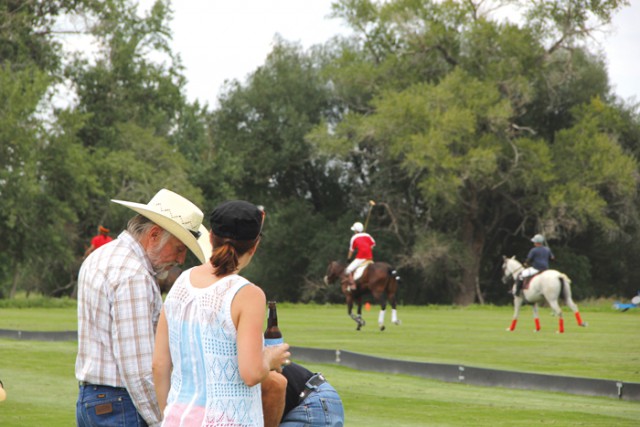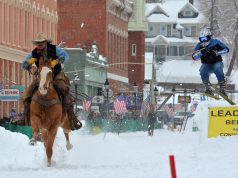
Despite its reputation as the sport of kings, Denver Polo Club Co-owner Erica Gandomcar insists it’s much more down-to-earth. Of the people even. And based on the crowd that gathered to watch the match on Aug. 10, it’s hard to disagree with her.
The attire is sun hats, plaid shirts and jeans. A line of pickups and Suburus are backed up to the field so people can tailgate. Two girls drive by in a John Deere golf cart shouting “Beer?” as a pit bull trots alongside nipping at the wheels. The teams on the field are delineated as red versus blue. One blue-team player has chosen a faded Superman T-shirt as a “jersey.” Later, there will be a barbecue emceed by a blues band in cowboy boots.
In a sentence: This polo match is all Julia Roberts and no Richard Gere.
“Polo is the great equalizer,” says Gandomcar. “Once you’re on a 1,000- pound horse, any skinny girl is just as powerful as a big guy.”
And while some might say the ability to afford a horse to play on — let alone multiple horses, as they are not allowed to play more than one sevenand-a-half-minute period (a chukker) consecutively in a game — might make it lean back towards the financial ele ments of kingliness, Gandomcar says you can play on a rental, just like a pair of bowling shoes.
And while the local polo field is not quite as centrally located as the average bowling alley, it’s closer than you’d think.
Just a half-hour south of Denver, a few minutes off of Highway 85, and down a dirt road flanked by two enormous salvaged P.F. Chang’s horse statues guarding the entrance like the sphinxes from The Neverending Story (How did they get there? “Everybody knows a guy,” Gandomcar says casually.), the Denver Polo Club offers group lessons starting at $80, as well as fullsize and arena-league play.
Sunday, Sept. 7 it will stage the Survivor’s Cup, a full-day polothon at the club including goal contests, awards and an Argentine barbecue that signals the end of the summer season and the start of the smaller-scale arena league. Like all matches, it’s free for spectators, with no dress code. Regular league play will resume in May.
And for any that see the match and wish to give it a shot, Gandomcar is glad to offer nuggets of wisdom like this one: “It’s like you’re bitch-slapping someone,” she says of the ideal mallet technique. “There’s a lot of bitchslap ping in polo.”
The target we are aiming for in the lesson is a purple cartoon waterhorse, grinning as it flashes us its backside, “the twerking hippo.” Another practice target is a clown’s mouth ringed with giant fangs. Possessed by World Cup fever, Gandomcar shouts, “Gooooooooooooooaaaaaaal!” when I finally knock the ball through the hippo’s legs.
But next comes the hard part: moving this croquet-match to horseback. And at least one of the horses is giving me a wary look. Gandomcar poo-poos it though.
“The key is that the horses all have personalities,” she says. “Wrigley [the horse with the stinkeye] is kind of a douche. Just a total bro. Ride him like that, and it’s no problem.”
Luckily, she puts me on Hawk, who she says, “Is cool, just like, whatever.”
When I get on top, I discover there is no knob to hold on to on the saddle. Gandomcar’s response?
“Neener-neener.” And off we go.
Gandomcar tells me to steer Hawk “like an Atari videogame.” The last time I rode any animal, it was a camel, and it tried to buck me off, after which it presumably planned to mount my carcass to a post as a warning to other tourists. So I’m understandably apprehensive. Especially that Hawk might take off running. But the problem is he’s not really going, just trudging forward a few steps at a time. You know, “cool.” The level of control is like running a three-legged race with a stubborn partner five times your weight.
“You gotta kick him, hard,” says Gandomcar.
“I was raised not to kick animals,” I say.
“He’s a thousand pounds,” she says. “You can’t hurt him.”
So I kick harder. And before you know it, we’re strolling down the enormous polo field, chasing the tiny white ball.
“Polo is part hockey, part golf, part chess match,” Gandomcar says.
The thing that feels like a closer analogy for me is a sport she didn’t mention: Little League Baseball. The painful awkwardness of no coordination and depth perception blurred by growth spurts feels pertinent. Also, the absurd thrill of connecting with the ball in any way is a sensation so disproportionate to the results (knocking the ball a dozen feet, tops) that I haven’t felt it since childhood.
Gandomcar says I’m doing well, but I’m mostly proud of neither plummeting to my death nor giving my horse a bloody nose.
And staying on the horse is key. Gandomcar says matches don’t stop if someone takes a spill because then it could be used as a defensive maneuver, like when soccer players take a dive. But it comes with a slightly higher risk of being trampled.
The whole experience gets a kick of turbo when Hawk picks up to a canter, which changes it from trying to play action-croquet, to trying to play it in an earthquake. The thought of doing this at 35 mph with other players dishing out 1,000-pound body checks is terrifying, and yet the appeal is clear. Strange as it may seem, the sport is a power equalizer, and success is much more about riding skill than bulk.
“So what’s an actual game like?” I ask.
“They start in the center,” she says. “The ref will bowl the ball in. And it’s pretty much chaos from there.”
Then we wrap it up for the day and head back to the office for Otter Pops.
In the distance, I can hear the whistle of a train.
Respond: [email protected]














